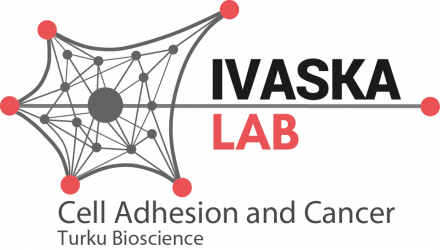-
Fibrillar adhesion dynamics govern the timescales of nuclear mechano-response via the vimentin cytoskeleton by Amy E M Beedle et al.
The cell nucleus is continuously exposed to external signals, of both chemical and mechanical nature. To ensure proper cellular response, cells need to regulate not…
-
Dynamic Micropatterning Reveals Substrate-Dependent Differences in the Geometric Control of Cell Polarization and Migration by Aleksi Isomursu et al.
Cells are highly dynamic and adopt variable shapes and sizes. These variations are biologically important but challenging to investigate in a spatiotemporally controlled manner. Micropatterning,…
-
Defined extracellular matrix compositions support stiffness-insensitive cell spreading and adhesion signaling by James R W Conway et al.
Integrin-dependent adhesion to the extracellular matrix (ECM) mediates mechanosensing and signaling in response to altered microenvironmental conditions. In order to provide tissue- and organ-specific cues,…
-
IGFBP2 secretion by mammary adipocytes limits breast cancer invasion by James R W Conway et al.
The progression of noninvasive ductal carcinoma in situ to invasive ductal carcinoma for patients with breast cancer results in a significantly poorer prognosis and is…
-
Myosin-X recruits lamellipodin to filopodia tips by Ana Popović et al.
Myosin-X (MYO10), a molecular motor localizing to filopodia, is thought to transport various cargo to filopodia tips, modulating filopodia function. However, only a few MYO10…
-
PP2A methylesterase PME-1 suppresses anoikis and is associated with therapy relapse of PTEN-deficient prostate cancers by Anna Aakula et al.
While organ-confined prostate cancer (PCa) is mostly therapeutically manageable, metastatic progression of PCa remains an unmet clinical challenge. Resistance to anoikis, a form of cell…
-
An extracellular receptor tyrosine kinase motif orchestrating intracellular STAT activation by Katri Vaparanta et al.
The ErbB4 receptor isoforms JM-a and JM-b differ within their extracellular juxtamembrane (eJM) domains. Here, ErbB4 isoforms are used as a model to address the…
-
MYO10-filopodia support basement membranes at pre-invasive tumor boundaries by Emilia Peuhu et al.
Ductal carcinoma in situ (DCIS) is a pre-invasive stage of breast cancer. During invasion, the encapsulating DCIS basement membrane (BM) is compromised, and tumor cells…
-
Publisher Correction: Cargo-specific recruitment in clathrin- and dynamin-independent endocytosis by Paulina Moreno-Layseca et al.
No abstract
-
Directed cell migration towards softer environments by Aleksi Isomursu et al.
How cells sense tissue stiffness to guide cell migration is a fundamental question in development, fibrosis and cancer. Although durotaxis-cell migration towards increasing substrate stiffness-is…
-
MASTL is enriched in cancerous and pluripotent stem cells and influences OCT1/OCT4 levels by Elisa Närvä et al.
MASTL is a mitotic accelerator with an emerging role in breast cancer progression. However, the mechanisms behind its oncogenicity remain largely unknown. Here, we identify…
-
Pressure Drives Rapid Burst-Like Coordinated Cellular Motion from 3D Cancer Aggregates by Swetha Raghuraman et al.
A key behavior observed during morphogenesis, wound healing, and cancer invasion is that of collective and coordinated cellular motion. Hence, understanding the different aspects of…
-
Platelet SHARPIN regulates platelet adhesion and inflammatory responses through associations with αIIbβ3 and LUBAC by Ana Kasirer-Friede et al.
Platelets form hemostatic plugs to prevent blood loss, and they modulate immunity and inflammation in several ways. A key event during hemostasis is activation of…
-
Cargo-specific recruitment in clathrin- and dynamin-independent endocytosis by Paulina Moreno-Layseca et al.
Spatially controlled, cargo-specific endocytosis is essential for development, tissue homeostasis and cancer invasion. Unlike cargo-specific clathrin-mediated endocytosis, the clathrin- and dynamin-independent endocytic pathway (CLIC-GEEC, CG…
-
SHANK3 conformation regulates direct actin binding and crosstalk with Rap1 signaling by Siiri I Salomaa et al.
Actin-rich cellular protrusions direct versatile biological processes from cancer cell invasion to dendritic spine development. The stability, morphology, and specific biological functions of these protrusions…
-
Sortilin-related receptor is a druggable therapeutic target in breast cancer by Hussein Al-Akhrass et al.
In breast cancer, the currently approved anti-receptor tyrosine-protein kinase erbB-2 (HER2) therapies do not fully meet the expected clinical goals due to therapy resistance. Identifying…
-
Myosin-X and talin modulate integrin activity at filopodia tips by Mitro Miihkinen et al.
Filopodia assemble unique integrin-adhesion complexes to sense the extracellular matrix. However, the mechanisms of integrin regulation in filopodia are poorly defined. Here, we report that…
-
Zebrafish Embryo Xenograft and Metastasis Assay by Ilkka Paatero et al.
Xenograft models, and in particular the mouse xenograft model, where human cancer cells are transplanted into immunocompromised mice, have been used extensively in cancer studies.…
-
Talin rod domain-containing protein 1 (TLNRD1) is a novel actin-bundling protein which promotes filopodia formation by Alana R Cowell et al.
Talin is a mechanosensitive adapter protein that couples integrins to the cytoskeleton. Talin rod domain-containing protein 1 (TLNRD1) shares 22% homology with the talin R7R8…
-
Integrin adhesion complexes by Megan R Chastney et al.
Tissue architecture and function are orchestrated by an intricate repertoire of cellular adhesion and signalling receptors, and by the surrounding extracellular matrix (ECM). The essential…
Our publications
For all publications visit Google Scholar

